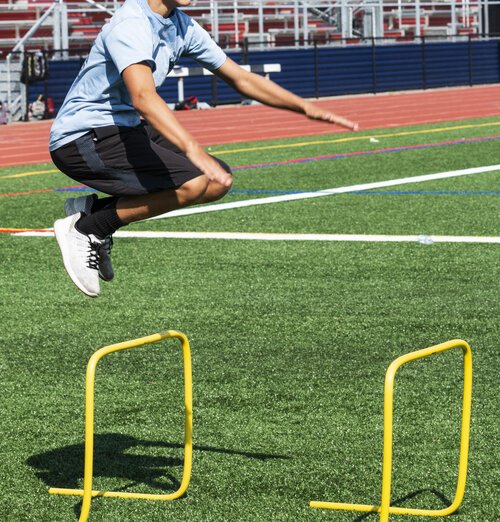Coach Education Resources

Plyometrics for Track and Field Coaches: A Practical Guide
Welcome to the wonderfully explosive world of plyometrics—a training tool that’s been around since Russian athletes were wearing tracksuits you could hear before you saw. Plyometrics, or “jump training,” is a must-have in any track and field coach’s toolbox. Whether you’re coaching sprinters, jumpers, throwers, or even endurance athletes, this form of high-intensity exercise bridges the gap between raw strength and sport-specific power.
Here’s your quick guide to implementing plyometric training with a pinch of practical advice.

Pool Running : Maximising Adaptations Beyond Rehabilitation
This article explores key benefits, effective techniques, and tailored session plans for both sprinters and distance runners of pool running. Whether you're looking to maintain fitness, build resilience, or introduce low-impact conditioning, this comprehensive overview will show you how to integrate pool running seamlessly into your training programs.

The Functional Movement Screen
The Functional Movement Screen (FMS) is a tool for evaluating an athlete's functional movement patterns. In this article, we break down how the FMS works, assess its effectiveness in identifying movement inefficiencies and asymmetries, and why it may be a useful addition to your coaching toolkit.

Hip Mobility and Flexibility for Track and Field
Read this academic article, published in the journal Advances in Physical Education, examining the importance of hip mobility and flexibility for track and field athletes. The article presents a program of nine mobility exercises and six flexibility exercises, with accompanying images, intended to improve hip range of motion and athletic performance.

What all Athletics Coaches Should Understand About Training and Muscle Fibres
Knowledge of muscle fibre types and how they can change is valuable for personalising training programs for different athletes’ goals. Understanding how different training modalities affect fibre type composition can help tailor programs for endurance, strength, power, or a combination of these qualities.

Eccentric Training Guidelines
This article explores updated guidelines for incorporating eccentric exercises into training programs, focusing on both developing and senior athletes. Key exercises like Nordic Hamstring Curls, Eccentric Squats, and Flywheel Leg Press are broken down with recommended sets, reps, and frequency. Backed by the latest research, these guidelines provide coaches with practical, science-based strategies to maximise performance while reducing injury risk.

Strength and Training - Athletics AI Summary
This presentation by Angus McEntyre, titled "Strength Training for Higher Performing Track & Field Athletes", provides a comprehensive guide for coaches on how to implement effective strength training programmes. The key theme revolves around the concept of "Developing Athleticism" by tailoring programmes to individual athletes and their specific events. The presentation stresses the importance of conducting thorough athlete assessments considering factors like training age, injury history, and individual needs.
Listen and read a summary of his presentation here.

Adding ‘No-Load’ Training Strategies into your Coaching Toolkit
No-load interventions, such as motor imagery, contralateral limb training, and passive blood flow restriction (BFR), offer effective methods for maintaining or improving strength without physical equipment or placing undue stress on an injured limb. Motor imagery, which involves mentally rehearsing exercises, has been shown to preserve and even slightly enhance muscle strength, making it useful during periods when physical training is not possible, such as during injury recovery, holidays, or travel to challenging environments.

Strength and Conditioning for Middle and Long Distance Athletes - Who Needs it?
The area of strength and conditioning has historically been lacking in the training programs of our potentially elite middle and long distance athletes. As a result, many of them are breaking down because they are not musculoskeletally strong enough to cope with high mileage or are burnt out because they are bored with training before they have a chance to achieve anywhere near their potential.
In this article, Di Huxley explores why and how strength and conditioning training should be incorporated for middle and long distance athletes.

How Many Times a Week Should a Muscle be Trained to Maximise Muscle Hypertrophy?
Training frequency is considered an important variable in the hypertrophic response to regimented resistance exercise. The purpose of this paper was to conduct a systematic review and meta-analysis of experimental studies designed to investigate the effects of weekly training frequency on hypertrophic adaptations.

Post-Activation Potentiation Improves Long Jump Performance
Discover how adding a set of drop jumps within two minutes of performing a long jump can enchance an athlete's performance in this peer-reviewed research summary.

Plyometrics and the High Jump
Plyometric training is a vital tool for track and field athletes, enhancing power and overall performance, particularly in events like the high jump. This article outlines the history, scientific principles, and practical applications of plyometric training, emphasising its significance for coaches and athletes alike.

Development Model for Strength Training
This table provides a long-term periodization model for strength and gives an overview of the development stages, training method, volume (quantity), intensity (load), and means of training.

Optimising Your Training at Altitude
Learn from Athletics Australia’s Lead Physiologist, Avish Sharma and Bryce Anderson as they make evidence informed recommendations for when, why, and how altitude training may be incorporated into an athletes’ training plan.

Athletic Plank Circuit
Core strength is a great asset for all Track and Field athletes.
Both traditional and modified plank exercises have been shown to effectively enhance core muscle endurance, strength, and dynamic stability. Check out this plank series that you can use with athletes of any event group.

Strength for Sprinting - Connecting Gym Gains with Sprinting Performance
What can the coach do to ensure that the time the athlete is spending in the weights room is being used most effectively for performance gains? This article looks at how we can select exercises in the gym that have the greatest transfer to sprinting performance.

Plyometrics - Four Studies All Track and Field Coaches Should Understand
This article will examine four key research papers on the benefits and sport-specific effectiveness of plyometrics training. We will examine their findings and place the results in the context of the wider peer-reviewed literature and expert opinion on the topic.

Complex Training for Track and Field
This article will explain what is meant by the term ‘Complex Training’, how it may benefit your athletes, and how to implement a complex training session.

Core Training for Athletes - Applying the Science
Based on the article ‘Progressions of Isometric Core Training’ authored by Mendrin, Lynn, Griffith-Merritt, & Noffal (2016), Loren Landow takes us through the coaching points, progressions, and demonstrations for the exercises found to be the safest and most effective for the development of core strength and stability to improve performance and reduce the likelihood of injury.

Plyometrics for Sprinters and Hurdlers
Peter Hannan explains common questions about plyometrics and shares exercises that he finds useful for coaching sprinters, hurdlers and jumpers.

